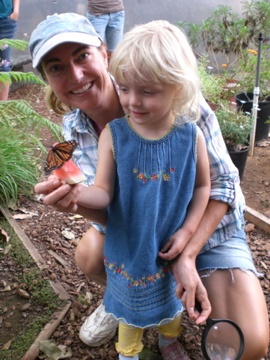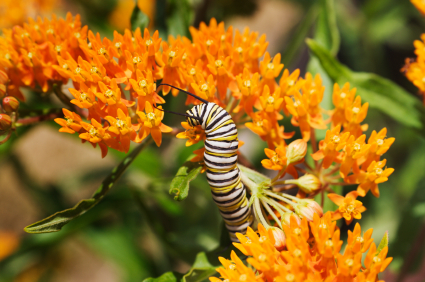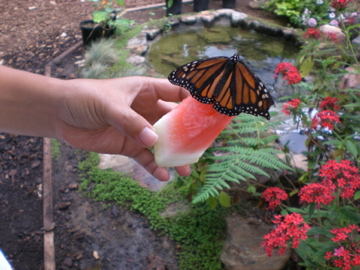
|
|
 |
||||||||||||||||||||
|
|
|||||||||||||||||||||
|
BUTTERFLY ALLEY Discovering More About the Magnificent Monarch Migration By Jeannine Clark  It isn’t often you drive into a storm of orange-and-black, tissue-paper-thin flapping wings. But on my way home one day, my car became engulfed in a cloud of butterflies - the tiny, delicate creatures dancing in a swirling, colorful blizzard. Their lightning-fast pace dropped butterfly dust on my windshield, as if the stamen from thousands of lilies had showered pollen all over my car. It isn’t often you drive into a storm of orange-and-black, tissue-paper-thin flapping wings. But on my way home one day, my car became engulfed in a cloud of butterflies - the tiny, delicate creatures dancing in a swirling, colorful blizzard. Their lightning-fast pace dropped butterfly dust on my windshield, as if the stamen from thousands of lilies had showered pollen all over my car.I parked and got out, surrounded by a swarm of airborne beauty. It was an incredible site: a few landed on my shoulders and on top of my head. I could feel them flutter against my skin, giving me thousands of “butterfly kisses.” Some followed me into the house, while others lingered in my backyard, taking sips of nectar from flowering plants in bloom. I had never seen anything like this before; it was truly magnificent. Questioning this strange occurrence led me to seek answers to what seemed to be a supernatural event. However, rare though it may be, what I had experienced was not quite a miracle, just a “massive migration of painted ladies moving through San Diego,” according to butterfly expert David F. Marriott, Ph.D., director of The Monarch Program in Encinitas, California. Inside the screened-in vivarium, or ‘Butterfly House,’ where the sun-drenched scientist (who actually graduated with his doctorate in musicology) works, he explained in a quiet, thoughtful tone, “When conditions are just right and we get an extraordinary amount of rainfall in February through March, followed quickly by warm Santa Ana’s, we end up with a huge population explosion.” The Butterfly House was not exactly what I expected: I imagined thousands of monarchs greeting me as I walked in; but that’s not what I found. Instead, Dr. Marriott told me there were about 80 monarch butterflies currently inside, along with a few other species that happen to sneak past the door. Not exactly a storm of flying beauty. I looked around and saw some resting high overhead, while others landed on nearby flowering shrubbery inside the little oasis.  One little girl holding onto a wedge of watermelon watched as a docile monarch nibbled right out of her hand. One little girl holding onto a wedge of watermelon watched as a docile monarch nibbled right out of her hand.We walked into the greenhouse filled with rows and rows of milkweed. I learned how weather plays a critical role in the monarch population. Not only does it affect migration patterns, but also food availability. Monarchs feed and lay their eggs on milkweed plants, their primary food source. Those eggs become caterpillars that feed on the milkweed leaves; without ample milkweed, few caterpillars survive. So it follows that fewer caterpillars lead to then fewer butterflies. Leaving the greenhouse, I journeyed through the agrarian lecture space, fitted with glass-enclosed casements, showcasing different species of butterflies. Dr. Marriott unfurled a large map showing me the different paths he’s tracked, thanks to reports from tagged butterflies found from Mexico to Washington. As Dr. Marriott explained, overall we’re seeing fewer butterflies. “Climate experts claim that global warming is intensifying nature’s cycles by lengthening fire seasons and prolonging droughts in parts of the west,” he tells me. In other words, dry or barren conditions mean reduced habitat, which spells trouble for population numbers.  Loss of habitat, due to illegal logging in Mexico and the destruction of eucalyptus groves for land development in California, have contributed to the recent decline in Loss of habitat, due to illegal logging in Mexico and the destruction of eucalyptus groves for land development in California, have contributed to the recent decline innumbers. “We’ve seen reduced numbers of butterflies in the last 15 years,” explained Dr. Marriott. “And monarchs play an important role as pollinators and as food sources in the food chain for other animals and insects.” So we’re all impacted as a result. You can see the magnificent migration during the autumn months of the year on the southwest coast of the United States. The optimal time to see the greatest numbers of butterflies is mid-November to mid-December. The long journey takes about 1800 miles and four generations before they make it back to where they started. The first generation begins their migration in wintering locations along the California coast; there, they cluster in eucalyptus trees along the coast, mating in late January and leaving for spring migration by March. The monarchs lay their eggs in the Sierra Nevada foothills and then die. The second generation hatches and flies across the mountains into Arizona, Oregon or Nevada. Third and fourth generations of monarchs spread out even further and then return to the California coast, to the place where their great, great grandparents began, often to the same exact tree. Scientists observe that more and more butterflies are becoming residents in one temperate location, not migrating. Dr. Marriott told me, “Santa Barbara County is home to more year-round monarch residents than any other county in California.” That coastal region also reports record numbers of overwintering sites and is a great place to witness migration patterns. Pismo State Beach reports the largest concentration of numbers, typically exceeding over 100,000. There are over 300 overwintering sites from south of Ensenada, to north of San Francisco (in Sonoma County). If you haven't been lucky enough to see a mass of butterflies migrating on their jubilant journey, I encourage you to add this glorious event to your bucket list. The sight is truly one of nature’s most awe-inspiring moments. There are many spots across the U.S. where you can spend a little time admiring one of Mother Nature’s incredible wonders, and you can find a complete list of places in California from Dr. Marriott’s webpage (listed below).  You can purchase chrysalis and milkweed from Dr. Marriott’s greenhouse in Encinitas to raise butterflies at home. At The Monarch Program, he not only educates visitors, but also provides the delicate insects to be used in gardens, or for release at weddings or funerals. FAST FACTS The Monarch Program (Encinitas, CA) (760) 944-7113 www.monarchprogram.org The Original Butterfly House (Mackinac Island, MI) (906) 847-3972 www.originalbutterflyhouse.com Panhandle Butterfly House (Nevarre, Florida) (850) 623-3868 www.panhandlebutterflyhouse.org Texas Discovery Gardens (214) 428-7476 www.texasdiscoverygardens.org To learn more about monarch butterflies in your region, visit: www.butterfly-houses.com; www.monarchwatch.org Photo credits: iStockphoto.com; Jeannine Clark |
|
|
|
|
| Site Map |